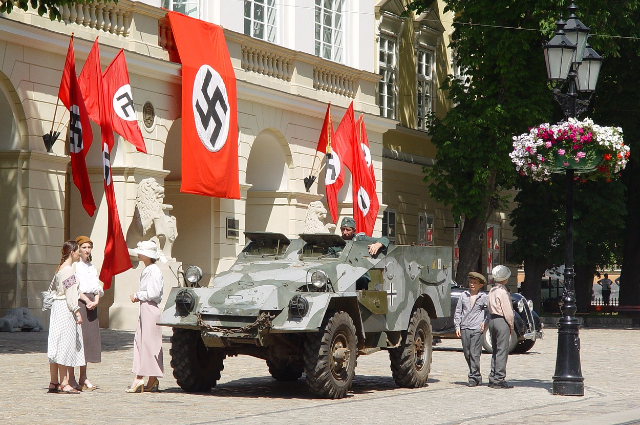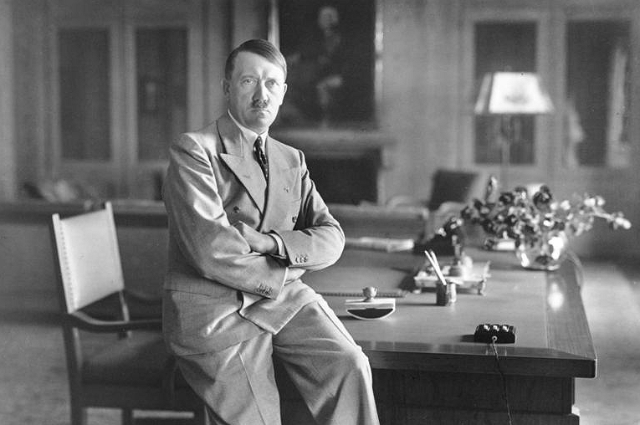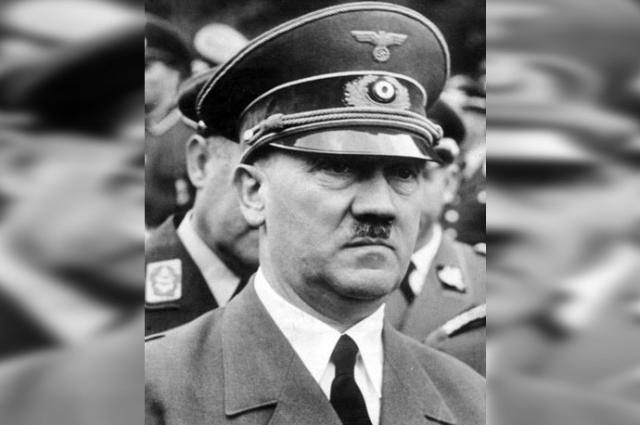Adolf Hitler, the infamous leader of Germany's Nazi Party was one of the most powerful and notorious dictators of the 20th century. His rise to power was marked by manipulation, persecution and violence that ultimately led to the devastation of World War II and the genocide of six million Jews.
“Anyone can deal with victory. Only the mighty can bear defeat” - Adolf Hitler
Rise to Power
Hitler's rise to power began in 1933 as he capitalized on economic hardships, social unrest, and political infighting to seize absolute control over Germany. His National Socialist German Workers' Party (NSDAP or Nationalsozialistische Deutsche Arbeiterpartei) swiftly suspended civil freedoms, dismantled independent organizations and established a one-party state.
Persecution and Oppression
The Nazis targeted various groups including political opponents, Communists, Social Democrats, homosexuals, Jehovah's Witnesses and gypsies. Most notably, Jews were subjected to brutal persecution that led to the Holocaust and the extermination of six million innocent lives.
Wartime Aggression and Defeat
In 1939, Germany invaded Poland, sparking World War II. By 1941, Nazi forces had conquered much of Europe. However, as the war turned against him, Hitler's grip on reality weakened, and his obsessive pursuit of Aryan supremacy only strengthened.
Downfall and Suicide
In April 1945, as Allied forces closed in on Berlin, Hitler committed suicide in his bunker which led to marking the end of his reign of terror. This research examines Hitler's rise to power, his dictatorial supremacy and his ultimate downfall. His legacy serves as a stark reminder of the dangers of extremism, prejudice and the unchecked pursuit of power. This article will delve into a deep analysis of why Adolf Hitler was known as a dictator and this article will answer questions such as what kind of journey Adolf Hitler had in his dictator rule? It will also elaborate about what was the genocidal killing and mass exploitation of rights done under Adolf Hitler's Nazi party rule?
The Developmental Years of Adolf Hitler
Early Life and Childhood struggles that followed
Adolf Hitler was born on April 20, 1889, in the small Austrian village of Braunau am Inn near the Austro-German border. His early childhood was spent in Linz, the capital of Upper Austria where his father, Alois, had retired as a state customs employee.
A Struggling Student
Hitler struggled in high school and eventually dropped out, refusing to follow in his father's footsteps as a public servant. Despite his father's wishes, Hitler pursued his passion for art but was rejected from Vienna's prestigious Academy of Fine Arts after his father died in 1903.
A Lonely and Voracious Reader
Following the death of his mother, Klara, in 1908, Hitler moved to Vienna, where he made a living painting scenery and monuments and selling postcards. During this time, Hitler became increasingly interested in politics, fueled by his loneliness, solitude, and voracious reading habits. It was during this period that he formulated many of the views that would later shape Nazi ideology.
The Making of a Political Mind
Hitler's years in Vienna were marked by a deepening interest in politics and a growing sense of isolation. Despite his struggles and setbacks, Hitler was determined to make a name for himself and leave a lasting impact on the world. Little did the world know, the seeds of Nazi ideology were being sown in the mind of a young and ambitious Adolf Hitler.
Military Career of Adolf Hitler and His Belief Towards the Weimar Republic
- Early Deployment and Honors: Adolf Hitler was sent to Belgium in October 1914 and served throughout World War I. He was recognized for his bravery, earning two honours including the prestigious Iron Cross First Class which he would proudly wear for the rest of his life.
- Injuries and Recovery: During the war, Hitler suffered two injuries. In 1916, he was wounded in the leg during the Battle of the Somme. Later in 1918, a British gas attack near Ypres caused him temporary blindness. While recovering in a hospital in Pasewalk, northeast of Berlin, Hitler learned about the ceasefire and Germany's defeat in World War I.
- Emerging Beliefs: Like many Germans at the time, Hitler started to believe that the country's defeat was due to internal "traitors" who lacked patriotism. This belief grew into a powerful narrative that undermined the Weimar Republic and eventually facilitated Hitler's ascent to power.
Nazi Party and the Rise of Hitler
- Joining the German Workers' Party: After returning to Munich in late 1918, Hitler joined the small German Workers' Party. This group aimed to combine working-class interests with strong German nationalism.
- Rise to Prominence: Hitler's charismatic presence and exceptional speaking skills quickly elevated him within the party ranks. By 1920, he had left the army to lead the party's propaganda efforts.
- Formation of the Nazi Party: The German Workers' Party was rebranded as the National Socialist German Workers Party, commonly known as the Nazi Party. Hitler played a significant role in adopting the hakenkreuz or hooked cross as the party's emblem. This symbol known as the swastika was featured in a white circle on a red background. Over time, the swastika became a powerful and deadly symbol under Hitler's regime.
Rise of Hitler and the Nazi Party
The Leadership of Hitler
By the end of 1921, Adolf Hitler had risen to become the leader of the burgeoning Nazi Party. He capitalized on the widespread discontent with the Weimar Republic and the harsh conditions imposed by the Treaty of Versailles. This period of dissatisfaction attracted many disillusioned former soldiers from Munich to the Nazi ranks among them Ernst Röhm, who established the Sturmabteilung (SA). These "strong-arm" units were tasked with protecting Nazi party gatherings and intimidating their opponents.
Electoral Struggles and Triumphs
Initially, the Nazi Party struggled to gain significant political traction. In the 1928 elections for the Reichstag which is the German parliament, they secured a mere 2.6% of the votes. However, by 1932 the political landscape had dramatically shifted with the Nazis becoming the most popular party saving 37% of the vote.
Hitler's Oratory Skills
A key factor in the Nazi Party's rise was Hitler's exceptional oratory skills. His speeches were charged with passion and charisma, resonating deeply with many Germans. He pledged to rebuild a powerful nation, rectify the perceived injustices of the Versailles Treaty and restore the dignity of the German people. Hitler's promises included providing jobs for the unemployed and securing a prosperous future for the youth. He also sworn to eradicate foreign influences and combat any supposed foreign conspiracies against Germany.
The Political Scene
Hitler introduced a novel approach to politics, emphasizing mass mobilization and the use of rituals and displays. The Nazis organized grand rallies and public meetings to demonstrate widespread support for Hitler and to foster a sense of unity among the public. These events featured red flags adorned with Swastikas, the distinctive Nazi salute and orchestrated rounds of applause following speeches. This theatrical display was designed to project power and instil a strong sense of solidarity among Germans.
The Dark Roots of Nazi Ideology: A Racial Hierarchy
The Nazi regime's heinous crimes were rooted in a twisted belief system that placed racial hierarchy above human equality. Adolf Hitler's worldview was deeply tangled with Nazi philosophy which categorized humans based on their physical characteristics. The "Aryan" race, characterized by blond hair and blue eyes sat at the top of this hierarchy, while Jews were relegated to the bottom as the "anti-race" and arch-nemesis of the Aryans. Other races were placed in the middle, judged solely on their exterior traits.
The Inspiration Behind Hitler's Racism
Hitler's racist ideology drew heavily from the ideas of Charles Darwin and Herbert Spencer, among others. Darwin was a natural scientist who developed the concepts of evolution and natural selection to understand the origins of plants and animals. Spencer later added the concept of "survival of the fittest," which theorized that only species that adapted to changing environments could survive. While Darwin never advocated for human intervention in this natural process, racist intellectuals and politicians exploited his theories to justify imperial domination over conquered peoples.
The Nazi Logic
The Nazi ideology was straightforward: only the strongest races would survive, while the weaker ones would perish. The Aryan race was deemed superior and needed to maintain its purity, grow stronger and dominate the world. This belief fueled Hitler's ambition to expand Germany's territory and bring all Germans together under one roof.
Lebensraum: The Geopolitical Concept of Living Space
Another crucial aspect of Hitler's ideology was the geopolitical concept of Lebensraum or living space. He believed that new territories needed to be secured for settlement, which would expand the mother country's territory, strengthen the German nation's material wealth and power and allow newcomers to maintain a strong bond with their ancestral homeland. This idea drove Hitler's push eastwards, aiming to expand German borders and unite all Germans in one location. The devastating consequences of this ideology were first experimented with in Poland.
The Nazi ideology was rooted in a toxic mix of racism, imperialism and geopolitical ambition. Hitler's beliefs which were inspired by twisted interpretations of scientific theories led to some of humanity's darkest moments. We must remember and learn from this history to prevent such atrocities from happening again.
The Nazi Dream: A Racially Pure Society

Image by Сергій Марищук from Pixabay
A Community of "Pure and Healthy Nordic Aryans"
Once in power, the Nazis set out to create an exclusive racial community of "pure" Germans, free from anyone deemed "undesirable". They believed that only a society of "pure and healthy Nordic Aryans" was worthy of existence. Anyone who didn't fit this criteria was seen as a threat to their racial purity and was deemed unworthy of life.
The Euthanasia Program: Murdering the "Unfit"
Nazi officials including Helmuth's father implemented the Euthanasia Program which resulted in the murder of countless Germans deemed mentally or physically unfit. This program was designed to eliminate anyone considered "filthy" or "aberrant" from the German gene pool.
Other "Undesirable" Groups
The Jewish community was not the only group labeled as "undesirable". Gypsies, blacks, Russians and Poles were also targeted as racial "inferiors" who threatened the superior Aryan race's biological purity. Many were persecuted, forced into slave labour and died as a result of their harsh conditions.
The Worst Victims: Jews in Nazi Germany
Jews were the worst victims of Nazi hatred which was fueled by traditional Christian anti-Semitism and pseudoscientific racial theories. They were portrayed as Christ's killers and were prohibited from owning land until the Middle Ages. They were confined to ghettos, subjected to organized violence and frequently expelled from the land. Hitler's hatred for Jews was founded on the belief that conversion was not a solution to "the Jewish issue" and that only elimination could remedy it.

The Nazi regime's dream of a racially pure society led to some of the darkest moments in human history. Their belief in the superiority of the Aryan race and their desire to eliminate all "undesirable" groups resulted in the murder of millions of innocent people. We must remember and learn from this history to prevent such atrocities from happening again.
Genocidal Campaign in the Shadow of the Second World War

Image by Dimitris Vetsikas from Pixabay
From 1933 to 1938, the Nazis inflicted terror upon the Jewish community by subjecting them to humiliation and isolation, ultimately driving them to leave Germany. However, the brutality escalated significantly between 1939 and 1945. During this period, Jews were forcibly concentrated in specific areas before being systematically eliminated in gas chambers in Poland.
Germany embarked on a horrific genocidal campaign during World War II, which led to the mass murder of various innocent European groups. The scale of this atrocity was staggering: six million Jews, 200,000 Gypsies, one million Polish civilians, and 70,000 Germans with mental and physical disabilities were killed alongside numerous political dissidents. The Nazis developed an unprecedented method of mass killing by gassing victims in concentration camps such as Auschwitz.
Despite the immense cruelty of these crimes, only eleven Nazi leaders were sentenced to death at the Nuremberg Trials while many others received life imprisonment. The punishment for these heinous acts was viewed by many as insufficient compared to the magnitude of the Nazis' atrocities. The Allies, mindful of the consequences of harsh penalties after World War I opted not to impose excessively severe punishments on the defeated Germany.
The Younger Generation in Nazi Germany
Hitler was deeply committed to influencing the youth of Germany. He believed that the foundation of a robust Nazi society lay in indoctrinating children with Nazi ideology. This required control over children both inside and outside the classroom.
Schools were thoroughly "cleansed" of undesirable elements. Jewish teachers and those considered politically unreliable were dismissed. Children were segregated with Germans and Jews forbidden from interacting. "Undesirable" children including Jews, the physically disabled and Romani children were expelled from schools and eventually sent to gas chambers in the 1940s.
Nazi education was a prolonged process of ideological indoctrination for "good German" children. Textbooks were rewritten to support Nazi racial theories and subjects like racial science were introduced to legitimize these ideas. Even math classes were used to promote pro-Nazi stereotypes. Children were taught to be obedient, loyal to Hitler, and to despise Jews. Sports were designed to foster aggression and hostility with boxing promoted to develop strength and a hard-hearted nature in boys.
The Culture of Motherhood under the Nazi Party
In Nazi Germany, children were taught that men and women had fundamentally different roles. The push for gender equality, a key aspect of democratic movements worldwide was dismissed as harmful. Girls were trained to become good mothers who would raise pure-blooded Aryan children while boys were trained to be aggressive and strong.
Girls were expected to maintain racial purity, avoid Jews, take care of their homes, and instill Nazi values in their children. They were seen as vital to preserving the Aryan race and culture. Hitler emphasized this in 1933, stating, "The mother is the most important citizen in my state." However, not all mothers were treated equally. Those who bore racially "undesirable" children were penalized, while mothers of racially "desirable" children received rewards such as better care in hospitals, discounts in stores, and honours like the Honour Cross given in bronze, silver, or gold, depending on the number of children they had.
Any Aryan woman who violated the expected conduct faced public humiliation and severe punishment. Women who associated with Jews, Poles or Russians were paraded with shaved heads, blackened faces and signs declaring they had dishonoured the nation. Many were imprisoned, lost their social standing and were abandoned by their families.
The Propaganda Art by Using Code Words and Media Support
The Nazi regime skillfully manipulated language and media by achieving significant influence. They used misleading terminology to describe their brutal tactics. Official communications avoided direct words like "kill" or "murder." Instead, they used euphemisms such as "special treatment," "final solution" for Jews, "euthanasia" for the disabled, "selection" and "disinfection" to refer to mass killings. Deporting people to gas chambers was referred to as "evacuation."
The Nazis expertly utilized the media to gain public support and promote their ideology. They employed visual images, films, radio broadcasts, posters, catchy slogans and leaflets to spread Nazi beliefs. Propaganda targeted groups labelled as enemies of Germany by depicting them as evil. Liberals and socialists were portrayed as weak, corrupt and dishonest foreign agents.
Propaganda films such as "The Eternal Jew" was made to incite hatred against Jews. These films stereotyped Orthodox Jews with beards and kaftans even though German Jews were highly assimilated and often indistinguishable by appearance. Jews were dehumanized and they were even compared to vermin, rats and pests with their movements related to rodents. This propaganda played on people's emotions by directing their hatred and anger towards those who were deemed undesirable.
The Nazis made a concerted effort to appeal to all segments of the population by suggesting that only they could solve the nation’s problems. By tapping into people's fears and prejudices, they manipulated public opinion and set their control.
End of World War II

Photo by Cook aynne on Unsplash
The tide of World War II turned against Germany following defeats at El Alamein and Stalingrad and the arrival of American soldiers in North Africa towards the end of 1942. The Allies started liberating towns across Europe shortly after their successful invasion of Normandy in June 1944. In December of that year, Hitler tried to split the British and American forces by launching an offensive through the Ardennes. However, by January 1945, he retreated to a bunker beneath Berlin's Chancellery. As Soviet forces closed in, Hitler considered but ultimately dismissed the idea of a last-ditch resistance.
Death of the Dictator
In the Berlin bunker, Hitler married Eva Braun at midnight on April 28-29. On April 30, after dictating his political testament, Hitler shot himself in his suite while Braun took poison. Following Hitler's instructions, their bodies were burned. On May 7, 1945 with Soviet troops occupying Berlin, Germany surrendered unconditionally on all fronts by ending the war in Europe.
Conclusion
It's misleading to see the collapse of the Weimar Republic and Hitler's rise as a unique German phenomenon. Between the world wars, democracies faltered across Europe and many have since. People lost their right to free speech and expression and were brainwashed into seeing Hitler as a "ray of hope" who would transform their lives. However, Hitler's so-called "Thousand-Year Rule" lasted just over 12 years which caused immense destruction and suffering, forever changing the course of history for Germany, Europe and the world.
. . .
References:
- https://www.jstor.org/stable/3180723
- https://www.britannica.com/biography/Adolf-Hitler
- https://www.biography.com/political-figure/adolf-hitler
- https://encyclopedia.ushmm.org/content/en/article
- https://www.nationalww2museum.org
- https://www.pbs.org/wgbh
- https://www.jewishvirtuallibrary.org/adolf-hitler
- https://www.encyclopedia.com/people
- https://spartacus-educational.com/GERhitler.html
- https://encyclopedia.ushmm.org
- https://www.history.com/topics/world-war



